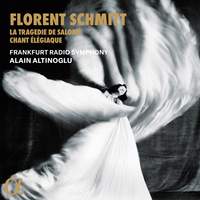Recording of the Week,
Florent Schmitt's ballet, La tragédie de Salomé
Intended as something of a moral antidote to both Richard Strauss's opera on the same narrative (which had received its first Paris performance six months before the completion of Schmitt's ballet) and the Oscar Wilde play on which Strauss's work was based, it focuses its attention on a series of dances that Salome performs for Herod. Although in this scenario John the Baptist does unfortunately still lose his head, here it is not at the behest of Salome herself, and indeed the horror of that event provides the catalyst for her final, frenetic "Danse de l'effroi" (Dance of terror).
This outstanding new performance from Alain Altinoglu and the Frankfurt Radio Symphony Orchestra joins an extremely small number of recordings of the original, full-length version, and it is most certainly a sumptuous treat. It's such a vivid score, all brought out beautifully by Altinoglu and his players, from the dusky, portentous strains of the opening prelude, to sultry, alluring strings in dialogue with a sensuous cor anglais in the introduction to the fourth tableau, which itself gives way to the proud brilliance of the Dance of the Peacock as Salome appears at the top of the staircase adorned with feathers and jewels.
There were several moments that reminded me of composers such as Wagner, Rimsky-Korsakov, and Dukas amongst others, but the most noticeable influence on Schmitt's style must surely be Debussy, with many sections sounding almost as if they could have been lifted straight from one of his works! It's not unreasonable, though, that Schmitt's piece should channel the composer of La mer, especially given that the sixth tableau presents a section entitled "Les enchantements sur la mer", a magical scene during which mysterious lights are seen to emerge from the depths of the sea.
As the music progresses inexorably to its conclusion, the Frankfurt players rise to the occasion gloriously. While Altinoglu maintains the smaller-sized wind and brass forces of the original version, he does not restrict himself to just twenty players, instead utilising a more generously-sized string section, and this seems to me to be an ideal balance between creating a rich, opulent sound whilst still retaining the colours of the original. The increased string section pays dividends particularly during Salome's aforementioned Dance of terror, where they match the menace and ferocity of the wind/brass by providing weight and heft that an ensemble of solo strings would find much trickier to achieve.
The very end is dramatic and thrilling, and it's not hard to imagine how this ballet, which culminates in a young woman dancing herself to a frenzy, should have inspired Stravinsky whilst he was composing The Rite of Spring shortly after. In another letter to Schmitt, Stravinsky also remarked, "God, how fine it is! It is one of the greatest masterpieces of modern music." With a recording as magnificent as this one, it is difficult to disagree.
Frankfurt Radio Symphony Orchestra, Alain Altinoglu
Available Formats: CD, MP3, FLAC, Hi-Res FLAC




